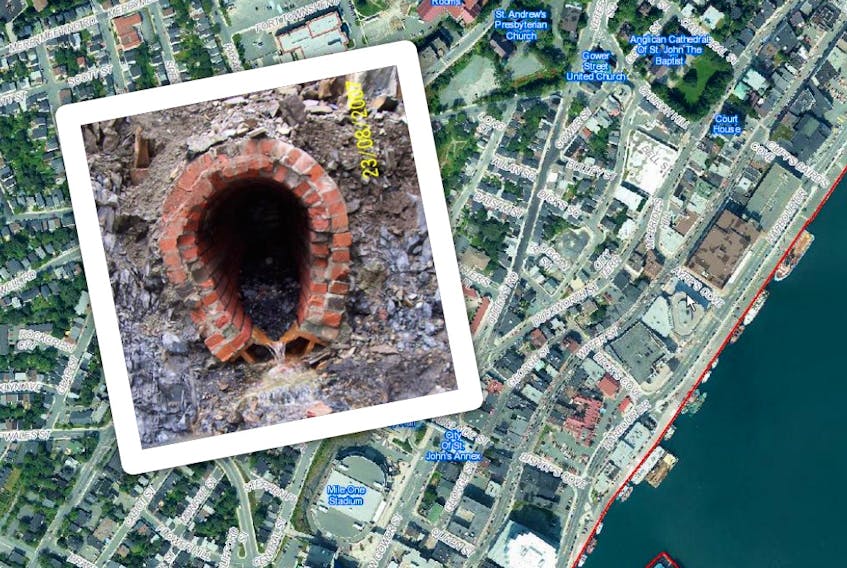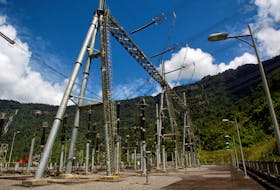Just imagine if the workers who — brick by laborious brick — constructed the large oval-shaped brick sewer line under Water Street in St. John’s more than 100 years ago could see how the city today intends to make it last another 50-plus years.
On Thursday, the City of St. John’s outlined its plan to use “trenchless technology” to replace the old underground water and sewer infrastructure under what is often referred to as North America’s oldest city street. The technology allows for a liner to be inserted into the old sewer pipe/brickwork.
The $15.5-million project will be cost-shared by the city (34 per cent), the provincial government (40 per cent) and the federal government (26 per cent).
The use of trenchless technology means the street will remain relatively intact, with only small areas of excavation, thus causing less of an impact on downtown businesses, and pedestrian and vehicle traffic flow.
“It is an approach to the Water Street infrastructure project which is minimally invasive,” said Coun. Dave Lane, who is the council contact for the project.
“Originally we were going to do a traditional infrastructure replacement, which meant digging up and doing excavation. Now we are going to have a lot less excavation. We are going to be doing trenchless technology in which we line pipes, but there will be some smaller excavation, particularly in intersections.”
The first phase of the five-year project will occur on the west end of Water Street between Queen Street and Bishop’s Cove.
City engineering staff are working with consulting engineering firm CBCL Ltd. to pre-qualify contractors in December and award the contract in early 2018 to facilitate work being able to start in early spring.
“The goal is to have the major work completed before the peak of each tourist season to minimize disruption,” Lane said. “This is in response to feedback we have received from the Downtown Stakeholder Committee and others in the past two years as we have prepared for this complicated and extensive project.”
Phase 2 in 2019 will occur between Bishop’s Cove and Ayre’s Cove; Phase 3 will be in 2020 and will run from Ayre’s Cove to Clift’s-Baird’s Cove; Phase 4 will run from Clift’s-Baird’s Cove to Job’s Cove; and Phase 5 will see the installation of the CIPP (Cured In Place Pipe) liner in the brick sewer at the Waldergrave /Water Street intersection.
Greg Sheppard, senior civil engineer with CBCL Ltd., said a special liner will be inserted into the brick sewer, inflated and cured, and then a robot will be sent through to cut holes for the pipes that connect to each business or building along the way.
“This liner consists of a fabric that carries an epoxy and it’s inserted into a sewer, so it’s basically like pulling a sock inside out,” Sheppard said. “Of course, with a sewer run you have other smaller pipes that go into the sewer that services the buildings. So what is done, before you even start that process, is the sewer is cleaned and the location of these service laterals is recorded. Once this CIPP liner is pulled into place and cured, then we go in with a robot and cut out the holes for the service laterals.”
Sheppard said the technology has been around for about 30 years and is quite common in North America. He noted the City of St. John’s already uses the technology to line modern water pipes, but the challenge with the old sewer pipe on Water Street is its shape.
“The biggest challenge is the shape of the main sewer that runs the entire length of the project. The material is brick and the shape is like an inverted egg,” Sheppard said. “Circles are the friendliest shape, they are easy to deal with. With a different shape, you have to have a special liner and it’s just a little trickier to do it. It takes a bit different technology, but it’s certainly achievable.”
The issue of replacing the aging underground water and sewer infrastructure on Water Street began to receive public attention in 2015. At that time, what became nicknamed the “big dig” was expected to start in 2016 and run for three to five years and involved the excavation of the entire street and replacement of the entire sewer system.
It was stopped, however, and the project revisited after many concerns were expressed about the impact of such a significant tear-up on businesses and tourism in the downtown core.
In the fall of 2015, the city established a Downtown Stakeholder Committee to share and discuss information related to the project and seek input. Ultimately, a recommendation to delay the project was made and in December 2016 the city announced it would rehabilitate the majority of the water and sewer infrastructure using trenchless technology.
“While the use of trenchless technology will minimize the need for extensive tear-ups along this busy and important street, traditional open excavation will also be required,” said Lane. “Our goal is to minimize the impacts, ensuring that vehicle and pedestrian access are maintained to the extent possible throughout the project’s complete timeline.”
Lane also noted the city will communicate with businesses and the public extensively in the preparation and construction phases, using its website to share project information and updates.








